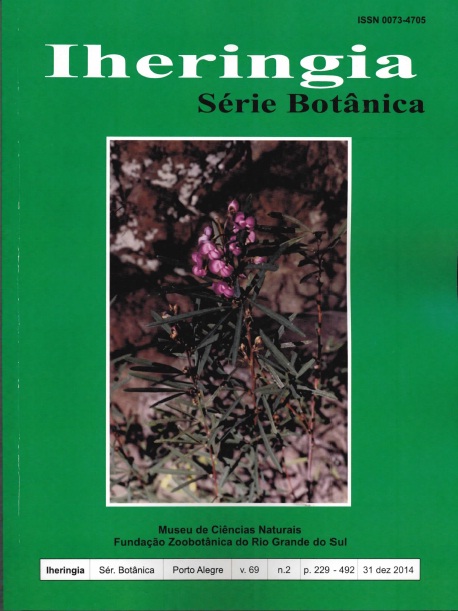Diversity and development of glandular trichomes in Lomatozona artemisiifolia Baker (Asteraceae - Eupatorieae)
Keywords:
ontogeny, secretory structures, vesicular trichomeAbstract
an endemic plant species from the Cerrado of Goiás. Lomatozona artemisiifolia is found only in the State of Goiás, Brazil. In this study we identifi ed glandular trichomes on aerial vegetative organs and fl owers, and described the main ontogenetic stages of trichomes in leaves and stems. Samples of stems, leaves, fl owers, and involucral bracts were analyzed under optical and scanning electron microscopy. L. artemisiifolia has glandular trichomes, classifi ed into four types. Type I has a uniseriate peduncle and biseriate head; type II is biseriate peduncular; type III is biseriate with a vesicular aspect; and type IV is uniseriate and curved towards the epidermis, with a long peduncle and unicellular head. The initial event in trichome development is the expansion of the protodermal cell. In trichomes with uniseriate peduncles, the fi rst division is periclinal. In biseriate trichomes, it is anticlinal. These results contribute to the knowledge on the genus and may support taxonomic studies of the tribe.
Downloads
References
Apezzato-da-Glória, Da Costa, F.B.C., Silva, V.C., Gobbo-Neto, L., Rehder, V.L.G. & Hayashi, A.H. 2012.
Glandular trichomes on aerial and underground organs in Chrysolaena species (Vernonieae – Asteraceae): Structure, ultrastructure and chemical composition. Flora 207: 878-887.
Ascensão, L. & Pais, M.S. 1987. Glandular trichomes of Artemisia campestris (ssp. maritima): ontogeny and histochemistry of the secretory product. Botanical Gazette 148:221-227.
Aschenbrenner, A.K., Horakh, S. & Spring, O. 2013. Linear glandular trichomes of Helianthus Asteraceae): morphology, localization, metabolite activity and occurrence. AoB Plants 5: 1-9.
Bozzola, J.J. & Russel, L.D. 1999. Electron Microscopy: principles and techniques for biologists. Jones and Bartlett Publishers, Boston. 670p.
Castro, M.M., Leitao-Filho, H.F. & Monteiro, W.R. 1997. Utilização de estruturas secretoras na identificação dos gêneros de Asteraceae de uma vegetação de cerrado. Revista Brasileira de Botânica 20(2): 163-174.
Cortadi, A., Di-Sapio, O., Mccargo, J., Scandizzi, A., Gattuso, S. & Gattuso, M. 1999. Anatomical studies of Baccharis articulata, Baccharis crispa and Baccharis trimera, “Carquejas” used in folk medicine. Pharmaceutical Biology 37(5): 357-365.
Hensel A., Maas, M., Sendker, J., Lechtenberg, M., Petereit, F., Deters, A., Schmidt, T. & Stark, T. 2011. Eupatorium perfoliatum L.: phytochemistry, traditional use and current applications. Journal of
Ethnopharmacology 138: 641– 651.
Johansen, D.A. 1940. Plant microtechnique. McGraw-Hill Book Company, New York. 523p.
Johnson, H.B. 1975. Plant pubescence: an ecological perspective. Botanical Review 41: 233-258.
Karnovsky, M.J. 1965. A formaldehyde-glutaraldehyde fixative of high osmolality for use in electrón microscopy. Journal of Cell Biology 27: 137-138.
King, R.M. & Robinson, H. 1987. The genera of the Eupatorieae (Asteraceae). Missouri Botanical Garden,St. Louis. Monographs in Systematic Botany, vol. 2, 581 p.
Kraus, J.E., Sousa, H.C., Rezende, M.H., Castro, N.M., Vecchi, C. & Luque, R. 1998. Astra blue and basic fuchsin double staining of plant materials. Biotechnic & Histochemistry 73(5):235-243.
Levin, D.A. 1976. The chemical defenses of plants to pathogens and herbivores. Annual review of Ecology and Systematics 7: 121-159.
Metcalfe, C.R. & Chalk, L. 1950. Anatomy of the dicotyledons. Claredon Press, Oxford. 1500p.
Monteiro, W.R., Castro, M.M., Mazzoni-Viveiros, S.C. & Mahlberg, P.G. 2001. Development and some histochemical aspects of foliar glandular trichomes of Stevia rebaudiana(Bert.) Bert. – Asteraceae. Revista Brasileira de Botânica 24: 349-357.
Nakajima, J.N., Junqueira, T.V., Freitas, F.S. & Teles, A.M. 2012. Comparative analysis of red lists of the Brazilian fl ora: Asteraceae. Rodriguésia 63(1): 039-054.
Oliveira, C.T. 2014. Lomatozona in Lista de Espécies da Flora do Brasil. Jardim Botânico do Rio de Janeiro. Disponível em: <http://floradobrasil.jbrj.gov.br/jabot/floradobrasil/FB27240>. Acesso em 13.02. 2014.
Paiva, J.G.A., Fank-de-Carvalho, S.M.t, Magalhães, M.P. & Graciano-Ribeiro, D. 2006. Verniz vitral incolor 500@: uma alternativa de meio de montagem economicamente viável. Acta Botanica Brasilica 20(2):257-264.
Picman, A.K., Elliott, R.H. & Towers, G.H. 1978. Insect feeding deterrent property of alantolactone. Biochemical Systematics and Ecology 6: 333-335.
Robinson, H. 2009. An introduction to micro-characters of Compositae. In: Systematics, evolution and biogeography of Compositae (V.A. Funk, A. Susanna, T.F. Stuessy & R.J. Bayer, eds.). International Association for Plant Taxonomy, Vienna, p. 89-99.
Roque, N., Bautista, H.P. & Mota, A.C. 2012. Taxonomic Revision of Trichogonia (Eupatorieae, Asteraceae): a South American Genus. Systematic Botany 37: 525–553.
Sass, J.E. 1951. Botanical microtechnique. Iowa State College Press, Ames. 228 p.
Solereder, H. 1908. Systematic anatomy of the dicotyledons. A handbook for laboratories of pure and applied botany. Clarendon Press, Oxford. 1182p.
Wagner, G.J. 1991. Secreting glandular trichomes: more than just hairs. Plant Physiology 96: 675-679.
Werker, E. 2000. Trichome diversity and development. In Advances in Botanical Reserch. Plant Trichomes (D.L. Hallahan, J.C. Gray & J.A. Callow, eds.), vol.31. Academic Press, Califórnia, p. 1-30.
Werker, E. & Fahn, A. 1981. Secretory hairs of Inula Viscosa (L.) Ait. - Development, Ultrastructure, and Secretion. Botanical Gazette 142: 461-476.







